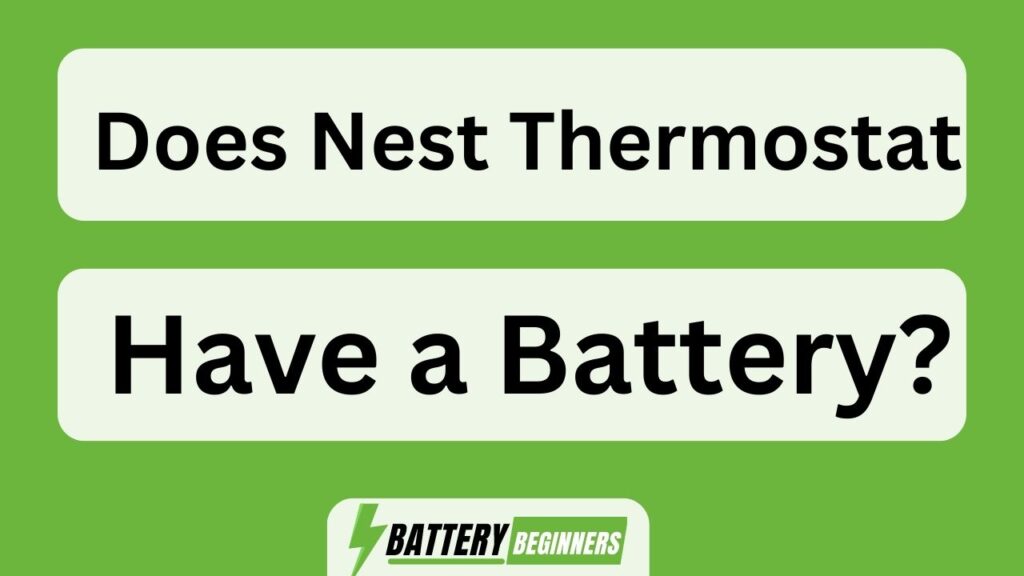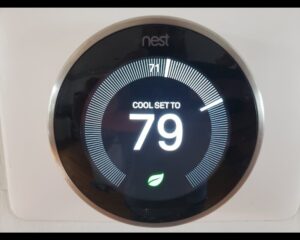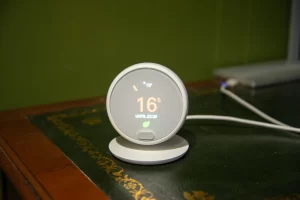Have you ever wondered if the Nest Thermostat has a battery? Well, get ready for some surprising answers.
In this article, we will delve into the power source of the Nest Thermostat and explore its benefits and limitations. We will also provide you with tips on how to check your thermostat’s battery status and extend its life.
So, if you’re curious about whether a battery-powered Nest Thermostat is right for your home, keep reading to find out all the essential information you need to make an informed decision.
Key Takeaways Does Nest Thermostat Have A Battery?
- The Nest thermostat has a built-in rechargeable battery that lasts for several years before replacement.
- The thermostat’s advanced algorithms and sensors optimize energy usage, helping to save on energy bills and contribute to a greener environment.
- If a C-wire connection is not available, a power extender kit can be used as an alternative solution for continuous power supply to the thermostat.
- When replacing the battery, it is important to choose compatible and high-quality replacement batteries to ensure optimal performance and avoid low-quality or counterfeit batteries.
Understanding the Power Source of the Nest Thermostat
Do you know if the Nest thermostat has a battery? Well, let me enlighten you on the power source of this smart device.
The Nest thermostat is primarily powered by your home’s electrical system, so it doesn’t rely solely on a battery. However, it does have a built-in rechargeable lithium-ion battery that serves as a backup power source in case of an electrical outage. This ensures that your thermostat continues to function and maintain its settings even during power interruptions.
Now, let’s talk about the benefits of having a battery-powered Nest thermostat.
One major advantage is that it provides peace of mind knowing that your thermostat won’t lose its programming or settings during a power outage. Additionally, troubleshooting battery issues becomes easier as you can simply check the battery level in the Nest app and replace it if needed.
With that said, let’s delve into the benefits of a battery-powered Nest thermostat without skipping a beat.
Benefits of a Battery-Powered Nest Thermostat
One of the advantages of a battery-powered Nest thermostat is its portability. Since it doesn’t rely on a direct power source, you have the freedom to install it anywhere in your home without worrying about electrical outlets. Additionally, a battery-powered Nest thermostat can be easily moved from one room to another, allowing you to optimize its placement for maximum efficiency.
When it comes to battery life, Nest thermostats are designed with power efficiency in mind. The batteries used in these devices have a long lifespan and can typically last for several months before needing to be replaced. This means that you won’t have to constantly worry about changing the batteries or losing functionality due to power outage.
In terms of power efficiency, Nest thermostats are known for their ability to regulate energy usage effectively. They use advanced algorithms and sensors to learn your heating and cooling patterns and adjust accordingly, resulting in optimized energy consumption and lower utility bills.
Transitioning into the limitations of a battery-powered Nest thermostat…
Limitations of a Battery-Powered Nest Thermostat
To maximize efficiency, you’ll need to consider the limitations of relying solely on battery power for your Nest thermostat.
While a battery-powered Nest thermostat offers convenience and flexibility, it does have some drawbacks. One limitation is that the battery life may vary depending on usage and environmental factors. It’s important to keep an eye on the battery level and be prepared to replace it when needed.
In addition, if the battery completely dies, your thermostat will lose power and stop functioning until it’s replaced or recharged. Troubleshooting a battery-powered Nest thermostat can also be more challenging compared to a wired one.
To ensure uninterrupted functionality, it’s crucial to regularly check the battery status of your Nest thermostat. This allows you to proactively address any issues before they become major inconveniences in maintaining optimal home temperature comfort levels without interruption.
How to Check the Battery Status of Your Nest Thermostat
Checking the battery status of your Nest thermostat is a simple way to ensure uninterrupted functionality. To check the battery status, follow these steps:
- Go to the Settings menu on your Nest thermostat.
- Select ‘Technical Info.’
- Scroll down to ‘Power’ and you will see the battery level indicated as a percentage.
It’s important to regularly check the battery status, especially if you notice any issues with your thermostat’s performance. If the battery level is low, it may be time for a replacement.
Nest thermostats are designed to be powered by an internal rechargeable lithium-ion battery, which eliminates the need for regular battery replacements. However, over time, this internal battery may start losing capacity.
In our next section, we will discuss some tips on extending the battery life of your Nest thermostat without compromising its performance or features.
Extending the Battery Life of Your Nest Thermostat
If you want to prolong the lifespan of your Nest thermostat’s battery, there are a few simple steps you can take. By following these battery saving tips, you can extend the battery life of your Nest thermostat and ensure it continues to function efficiently.
One way to conserve the battery is by adjusting the brightness level of the display. Setting it to a lower level will help reduce power consumption. Another tip is to disable the Wi-Fi when you don’t need it, as this feature can drain the battery quickly. Additionally, keeping your Nest thermostat away from direct sunlight and extreme temperatures will also help preserve its battery life.
Here is a table summarizing some helpful tips for extending your Nest thermostat’s battery life:
| Battery Saving Tips |
|---|
| Adjust display brightness |
| Disable Wi-Fi when not in use |
| Keep away from direct sunlight |
| Avoid extreme temperatures |
By implementing these strategies, you can maximize the longevity of your Nest thermostat’s battery.
Now let’s move on to troubleshooting any potential battery-related issues with your Nest thermostat without skipping a beat.
Troubleshooting Battery-Related Issues with Your Nest Thermostat
To troubleshoot any potential issues with your Nest thermostat’s battery, you can try adjusting the display brightness or disabling the Wi-Fi when not in use. These simple steps can help conserve battery life and prevent common battery issues.
If you find that your Nest thermostat is not holding a charge or experiencing rapid battery drain, you may need to consider troubleshooting or replacing the battery. Start by checking if the battery contacts are clean and free from any debris. Additionally, make sure that the thermostat is securely connected to its base.
If these steps don’t resolve the issue, it might be time to replace the battery. However, before jumping to that conclusion, it’s worth exploring alternatives to battery-powered Nest thermostats for a more efficient and sustainable solution.
Alternatives to Battery-Powered Nest Thermostats
Moving on from troubleshooting battery-related issues, let’s explore alternatives to battery-powered Nest thermostats. One popular option is harnessing alternative power sources such as solar energy. By using solar panels to generate electricity, you can ensure a continuous and sustainable power supply for your thermostat.
To give you a clearer picture, imagine a 2 column and 4 row table in markdown format:
| Alternative Power Sources | Benefits |
|---|---|
| Solar energy | Sustainable and clean |
| Geothermal energy | Efficient and reliable |
| Wind energy | Renewable and abundant |
| Hydroelectric power | Environmentally friendly |
By utilizing these alternative power sources, you can reduce your reliance on batteries and minimize the risk of running out of power during critical moments. Now that we’ve explored alternative options, let’s delve into considering your home’s power infrastructure for optimal thermostat performance.
Considering Your Home’s Power Infrastructure
When considering your home’s power infrastructure for a Nest thermostat, it is important to evaluate the wiring system in your home. This involves assessing the compatibility and capacity of your current wiring to support the thermostat’s power requirements.
If you are unsure about any aspect of your home’s wiring, it is advisable to consult with a professional electrician who can provide expert guidance and ensure that the installation process is safe and efficient.
Evaluating the Wiring System in Your Home
Check if your home’s wiring system is compatible with a Nest thermostat. Evaluating wiring efficiency is crucial to ensure that the Nest thermostat functions optimally in your home. Understanding electrical compatibility is essential as it determines whether your current wiring setup can support the power requirements of the thermostat.
Start by examining the type and condition of your existing wires, ensuring they are in good shape and meet the necessary specifications for a Nest thermostat installation.
Additionally, evaluate if your home has a common wire (C-wire) connection available. This wire provides continuous power to the thermostat, allowing it to operate smoothly without draining its battery. If your wiring system lacks a C-wire, you may need to consider alternative solutions such as using a power extender kit or hiring an electrician to install one.
Remember, consulting with a professional electrician can provide valuable insights into assessing the compatibility of your current wiring system and make any necessary modifications for seamless integration with your new Nest thermostat.
Consulting with a Professional Electrician if Needed
If you’re unsure about the compatibility of your home’s wiring system, it’s a good idea to consult with a professional electrician. They have the expertise and knowledge to evaluate your current setup and determine if any modifications are needed for installing a Nest thermostat.
A professional electrician can assess the wiring in your home, ensuring that it meets the necessary specifications for safe and efficient use of the thermostat. They can also provide guidance on any potential upgrades or changes that may be required.
Consulting with a professional electrician will give you peace of mind, knowing that your Nest thermostat installation is being handled by an expert.
Once you have confirmed the compatibility of your wiring system, it’s important to consider battery safety and environmental considerations when using your Nest thermostat.
Battery Safety and Environmental Considerations
The Nest thermostat’s battery should be handled with care due to safety and environmental considerations. When it comes to battery disposal, it is important to follow proper procedures to ensure that harmful materials are not released into the environment.
Additionally, when replacing the battery in your Nest thermostat, it is crucial to choose a compatible and high-quality replacement to maintain optimal performance. Here are three things to keep in mind:
- Dispose of the old battery responsibly by recycling it at designated collection points or through electronic waste recycling programs.
- Avoid using low-quality or counterfeit batteries as they may not provide reliable power and could potentially damage your thermostat.
- Consider rechargeable batteries as an eco-friendly alternative that can help reduce waste.
By being mindful of these factors, you can maintain the safety of your home while also minimizing your impact on the environment. Making an informed decision for your Nest thermostat involves considering both technical specifications and ecological considerations.
Making an Informed Decision for Your Nest Thermostat
When making a decision for your Nest thermostat, it’s important to consider both technical specifications and ecological factors.
One key aspect to think about is battery replacement. The Nest thermostat does have a built-in rechargeable battery that powers its functions. This means you don’t have to worry about constantly replacing batteries like with traditional thermostats. The rechargeable battery can last for several years before needing to be replaced.
Another important consideration is energy efficiency. The Nest thermostat is designed to help you save energy and reduce your carbon footprint. It uses advanced algorithms and sensors to learn your schedule and adjust the temperature accordingly, optimizing energy usage without sacrificing comfort.
By using the Nest thermostat, you can potentially save on your energy bills while also contributing to a greener environment.
Overall, when deciding on a Nest thermostat, it’s crucial to take into account its battery replacement capabilities and its commitment to energy efficiency.
Frequently Asked Questions
Can I use my Nest Thermostat without a battery?
Yes, you can use the Nest Thermostat without a battery when using external power. This allows for continuous operation and eliminates the need to replace batteries. However, having a battery provides backup power in case of a power outage, ensuring uninterrupted functionality.
How long does the battery of a Nest Thermostat typically last?
The battery lifespan of a Nest thermostat varies depending on usage, typically lasting between 3-5 years. When the battery needs replacement, it is recommended to contact Nest support for assistance.
What happens if the battery of my Nest Thermostat dies?
If the battery of your Nest thermostat dies, you will need to replace it. To troubleshoot the battery, check if it is properly connected and clean the contacts. If these steps don’t work, contact Nest support for further assistance.
Can I replace the battery of my Nest Thermostat on my own?
Yes, you can replace the battery of your Nest thermostat on your own. Simply follow the troubleshooting guide provided by Nest to safely replace the battery and ensure your thermostat continues to function properly.
Are there any risks or safety concerns associated with using a battery-powered Nest Thermostat?
Yes, there are some risks and safety concerns associated with using a battery-powered thermostat. These include potential fire hazards if the battery is not properly maintained or installed, as well as the risk of electrical shock if mishandled.
Conclusion
In conclusion, the Nest Thermostat is a popular choice for homeowners looking for energy-efficient temperature control. It is powered by your home’s electrical system and does not have a built-in battery.
One interesting statistic to note is that according to a study conducted by Nest, their thermostat can save homeowners an average of 10-12% on heating and 15% on cooling bills annually.
With its smart features and potential cost savings, the Nest Thermostat is definitely worth considering for your home.






